Hawaiian monk seal born at North Kona beach ‘doing good’


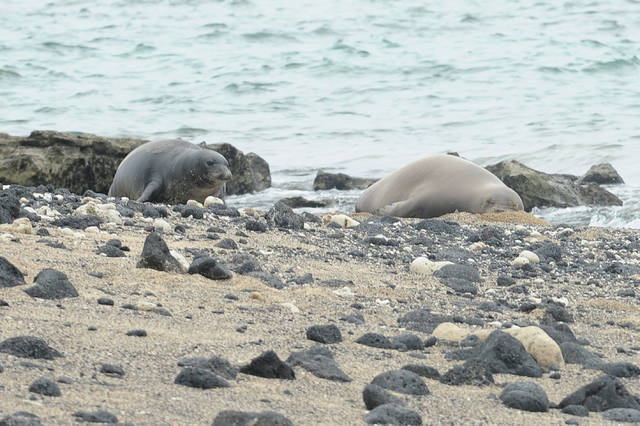

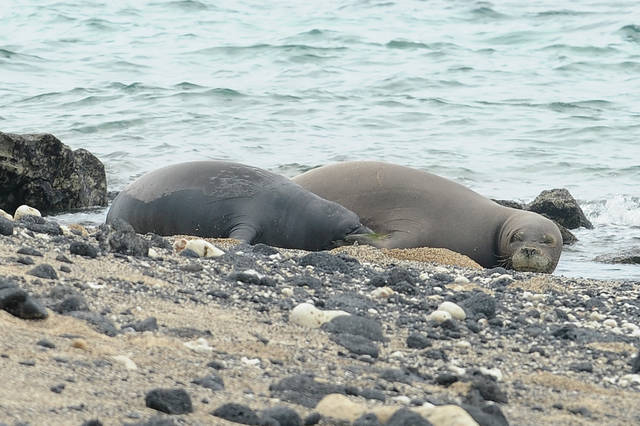
Hawaiian monk seal RA20 feeds her pup Manu‘iwa at Mahaiula Bay on Friday. (Laura Ruminski/West Hawaii Today)
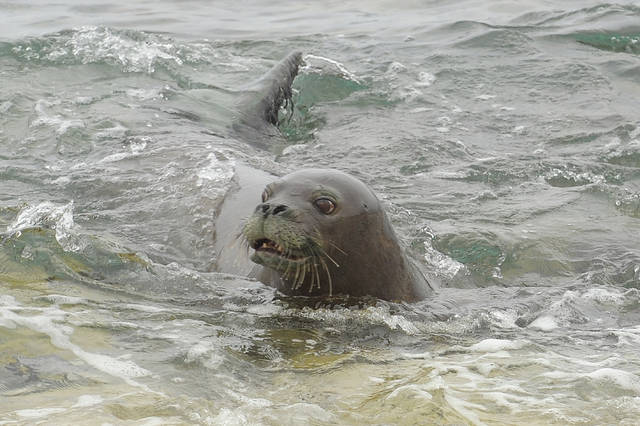
Hawaiian monk seal RA20 looks for her pup Friday at Mahaiula Bay. (Laura Ruminski/West Hawaii Today)

Mother Hawaiian monk seal RA20 barks for her pup Friday at Mahaiula Bay. (Laura Ruminski/West Hawaii Today)
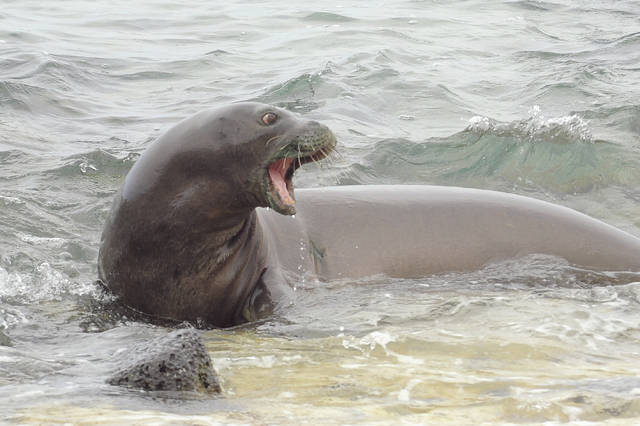
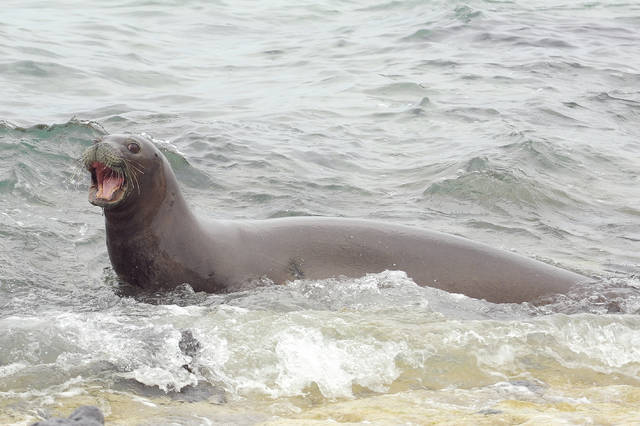

Hawaiian monk seal RA20 nuzzles with her pup Manu‘iwa at Mahaiula Bay on Friday. (Laura Ruminski/West Hawaii Today)

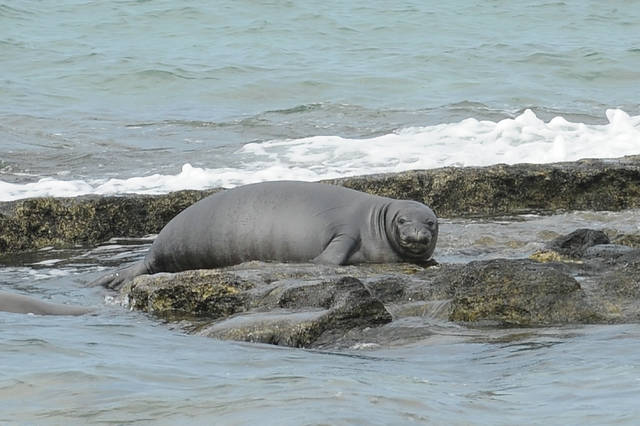
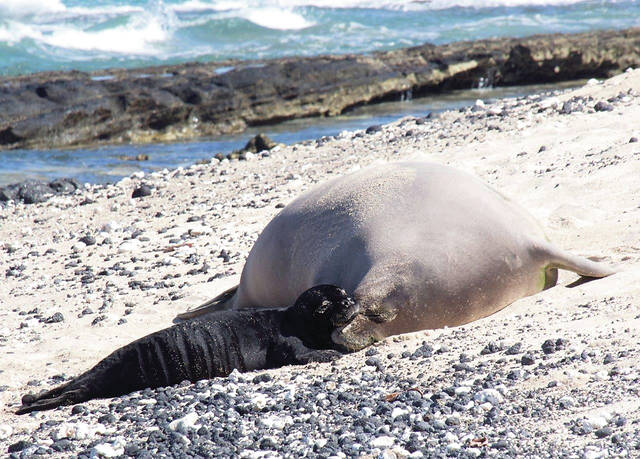
Manu‘iwa, as the female pup has been named, was born Feb. 8 to RA20, a 10-year-old female monk seal that does not have a nickname, at a beach on the Kona Coast. (Barry Brunt/Special to West Hawaii Today)
KAILUA-KONA — Manu‘iwa is packing on the pounds and growing up quick.
KAILUA-KONA — Manu‘iwa is packing on the pounds and growing up quick.
In just a couple weeks, the Hawaiian monk seal pup is expected to be on her own when mom, RA20, decides her time rearing her little one is up and takes off. It’s a normal part of every seal’s life, and Manu‘iwa appears to be on track for success.
“She’s doing good and gaining on schedule,” said Sylvester Orosco, The Marine Mammal Center’s Ke Kai Ola Hawaiian Monk Seal Hospital response manager and animal care specialist. The center and its force of volunteers have been keeping tabs on the pair as well as ensuring that curious visitors remain at a safe distance while checking out the mammals.
Since coming into the world Feb. 8, when the little fuzzy, black pup weighed just 25 pounds, Manu‘iwa has been bulking up thanks to mom’s rich milk. Each day, the seal gains about 5 pounds.
As of Friday, Manu‘iwa weighed an estimated 175-200 pounds and already shed much of her black birth fur in favor of the typical seal’s silvery-gray back with a lighter underside.
She’s honing her skills with mom teaching her the ropes in the bay’s protected waters during the one- to two-week weaning process.
“In the last two weeks, they’ve actually been going swimming and playing out behind the reef shelf,” said Orosco, pointing to a rocky outcropping about 20 to 30 feet offshore. “Every day, she gets stronger. Mom’s teaching her how to fish and use her flippers.”
Soon, 10-year-old RA20 will head out to sea, leaving Manu‘iwa to fend for herself, as mother seals usually nurse pups about six weeks.
Some believe it will occur before month’s end, but Orosco — who’s had a lot of time observing the pair — thinks mom will hang around a little longer. He said RA20 is very affectionate and nurturing with the pup, often playing and interacting with it more than he has seen with other seals.
“I think she’ll nurse longer,” he said, estimating RA20 will part ways with her offspring during the first week of April.
Once RA20 leaves, Manu‘iwa will be tagged, and it’s likely she will hang around her natal beach for about a month or so before venturing farther. Once alone, it becomes even more critical that to keep her wild, humans must in no way interact with the seal. The Hawaiian monk seal is federally listed as an endangered species with just 1,400 specimens estimated to live in the main and Northwestern Hawaiian Islands.
“Once the pup is weaned, it’s going to be really curious and that’s when it’s more susceptible to being ‘habitated’ to people,” Orosco said.
It’s also critical that people do not swim with the pup. Should an interaction occur, people should pause and settle themselves down before slowly removing themselves from the area, said Orosco.
And, should someone be fishing and notice any monk seal, whether pup or adult, in the area, they should reel in their catch as quickly as possible to ensure the monk seal does not ingest a hook or become accustomed to securing a meal that way.
Ke Kai Ola volunteers will continue to monitor Manu‘iwa, ensuring that people remain safe and at a distance during that time. It takes three shifts with two to four volunteers each to keep tabs on and educate curious beachgoers about the monk seal during park hours, 8 a.m. to 7 p.m.
One of those volunteers there Friday was Wendy Minor, who’s given her time to the nonprofit for the past year and a half.
She sees her role as “guarding the people” rather than “guarding the seal,” ensuring humans remain safe while getting the experience of seeing such a rare mammal.
Her favorite part has been the opportunity to share her knowledge and meet so many people while watching Manu‘iwa grow up.
And, she added, “what better office can you have?”
Ke Kai Ola also needs volunteers to monitor other seals that show up along the Big Island coastline, like earlier this week when a monk seal came ashore in Kailua Village. Those interested in volunteering with the nonprofit should contact Orosco via email to oroscos@tmmc.org.



Headlining with the location is VERY irresponsible on WHT’s part.
I am glad to hear the baby seal is doing WELL….. however supposedly professional writers should know that doing good is incorrect English and they are setting a bad example to students who read a heading “doing good.” 5th graders need to know the difference between using an adjective and an adverb as they are asked to diagram sentences and writers should not be contributing to students getting a bad grade from reading a Hawaiian newspaper.